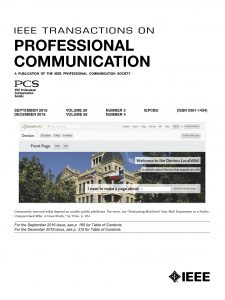Entrepreneurship Communication (4Q16 Special Issue)
Published on November 29, 2016
 The December 2016 special issue of the IEEE Transactions on Professional Communication on entrepreneurship communication has recently been published online. If you are a paper subscriber, you will receive the issue, printed together with the September issue, during the next month.
The December 2016 special issue of the IEEE Transactions on Professional Communication on entrepreneurship communication has recently been published online. If you are a paper subscriber, you will receive the issue, printed together with the September issue, during the next month.
Volume 59, Number 4, December 2016
Editorial— Introduction to the Special Issue on Entrepreneurship Communication, by C. Spinuzzi
This special issue presents recent work on entrepreneurship communication from a professional communication perspective. The articles answer questions such as What acts of communication do entrepreneurs undertake? How do they see themselves as entrepreneurs and communicators? What stories do they tell, and what makes these stories persuasive? How do they use pitches to persuade audiences, and what makes these pitches persuasive? How do they use signage persuasively?
Research Article— Throwing a Change-Up, Pitching a Strike: An Autoethnography of Frame Acquisition, Application, and Fit in a Pitch Development and Delivery Experience, by S. J. Belinsky and B. Gogan
This study investigates how one entrepreneur acquired, applied, and fit frames to her startup venture and stakeholders over one year. Research questions: How do pitchers acquire frames for pitches? How do pitchers apply frames to existing pitches? How do pitchers gauge the fit between the innovation, frames, and stakeholders?
Research Article— Networking in a Field of Introverts: The Egonets, Networking Practices, and Networking Technologies of Technical Communication Entrepreneurs, by B. Lauren and S. Pigg
Although labor statistics document a steady rise in contract, contingent, and entrepreneurial labor, knowledge about the professional communication practices that build and sustain independent careers in the field of technical communication largely emerges from broad survey analysis, cultural/social critiques, or individual anecdotes. From these statistics and stories, we already know that independent technical communicators face challenges when they start and maintain businesses. Drawing on thick qualitative description from semi-structured interviews, this article responds to the need for more systematic research tracing the networking practices, technologies, and relationships that enable independent work.
Research Article— Communicating Entrepreneurial Passion: Personal Passion vs. Perceived Passion in Venture Pitches, by K. Lucas, S. A. Kerrick, J. Haugen, and C. J. Crider
Entrepreneurial passion has been shown to play an important role in venture success and therefore in investors’ funding decisions. However, it is unknown whether the passion entrepreneurs personally feel or experience can be accurately assessed by investors during a venture pitch. Research questions: (1) To what extent does entrepreneurs’ personal passion align with investors’ perceived passion? (2) To what cues do investors attend when assessing entrepreneurs’ passion?
Research Article— A Narrative Perspective on International Entrepreneurship: Comparing Stories from the United States, Spain and China, by S. D. Williams, G. Ammetller, I. Rodríguez-Ardura, and X. Li
This study investigates entrepreneurship as a rhetorical practice and seeks to illustrate how narratives of individuals from different cultures create a discourse of entrepreneurship. We offer theoretical and methodological considerations for comparative international analyses in entrepreneurship research. Research questions: (1) How do the stories that are told by entrepreneurs from different cultures reveal their values? (2) What can those stories tell us about entrepreneurship in different cultures?
Teaching Case— Lookalike Professional English, by T. van Hout and E. van Praet
Our teaching case reports on a fieldwork assignment designed to have master of arts students experience first-hand how entrepreneurs write for the globalized marketplace by examining public displays of language such as billboards, shop windows, and posters. Research questions: How do entrepreneurs use English to “style” themselves? What is the status of English in public displays? Which relationship with customers is cultivated by using English (among other languages)? How does English, or lookalike versions thereof, create a more innovative business?
Teaching Case— Rhetorical Work in Crowd-Based Entrepreneurship: Lessons Learned from Teaching Crowdfunding as an Emerging Site of Professional and Technical Communication, by K. P. Vealey and J. M. Gerding
Given the expanding boundaries of entrepreneurship, it is increasingly important to prepare students to be ethical entrepreneurs and embody a widening array of rhetorical skills. This teaching case addresses the question of how we might incorporate new and emerging forms of entrepreneurship, such as crowdfunding, into the professional and technical communication classroom in ways that foreground the social, civic, and ethical dimensions of that work.
Book Review— John Hartley, Wen Wen, and Henry Siling Li, Creative Economy and Culture: Challenges, Changes, and Futures for the Creative Industries, Reviewed by S. Carradini
The issue is available online at: http://ieeexplore.ieee.org/xpl/RecentIssue.jsp?punumber=47. Note that a user ID and password are required to view individual articles.

